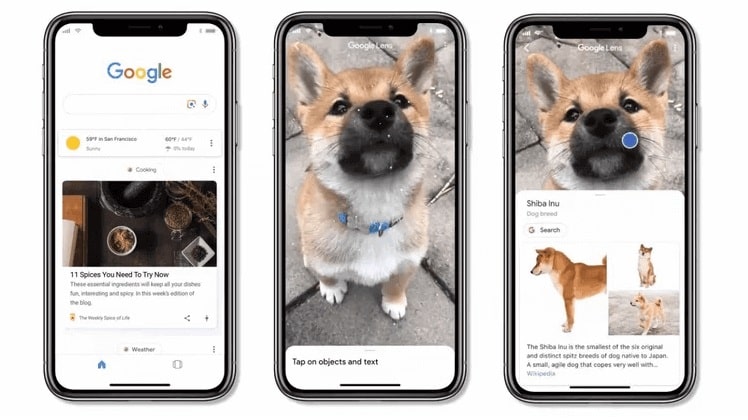Visual Search (Reverse Image Search): Have you seen something and wanted to buy the exact same object but cannot find it online or cannot even describe it? Well, you now don’t have to spend hours searching on the web because visual search allows you to take a photo and upload it to a visual search engine like Google for similar results. But if website images are not updated and optimized, then they will not appear on search results.
The most popular visual search engines are Google Lens, Bing, and Pinterest Lens. These lenses can scan the physical world and aid users in visual search down to specifics. It helps users find exact products, as shown in the image.
Top 4 Ways to Optimize Your Website for Visual Search (Reverse Image Search)
Visual search is still an emerging concept as online businesses are still in the transition phase. It is essential for attracting traffic and increasing sales. Here are some best practices to optimize images if you want your website to appear in a visual search.
1) Use Structured Data:
When optimizing for visual search and adding more content to your website, it is vital to provide the search engine with as much information as possible. Instead of being vague, use structured data for images, which helps your site to appear in Google as rich snippets (Google search results with displayed data).
In order to increase the performance of your website by enhancing visual search, you can mark up your site pages by using the following formats:
- Microdata
- RDFa
- JSON-LD (recommended by Google)
Your structured data should be relevant to your page content—for example, a makeup site labeling instructions as recipes. You can also get the help of an experienced website maintenance company regarding your website redesign and visual uplifts, so there are no mistakes in scripts.
2) Incorporate Alternative Descriptions:
Alternate descriptions are also called “alt tags” or “Alt Text,” this description appears in place of an image when the image cannot load on the screen due to technical issues. But why is this alternative description important? Well, because search engines read it, it helps them understand the context of an image.
The alt text is not only used by search engines but also by viewers to understand the meaning of a picture. For example, if there is an image of a man holding a dumbbell, your alternative description can be like this: “Young, the athletic man holding a dumbbell during his workout at the gym.” When you add this text to your website, ensure it is concise and honest.
3) Update Filenames:
Context is everything when it comes to website design. It is essential when you cater to a broad audience. Although the majority of the time, images are named something like “IMG_12345.jpg”, it is best to provide as much information as you can regarding image tags. These kinds of generic names will not help Google or users.
Instead of confusing your users with images named “IMG_12345.jpg”, rename them with details like “dog-with-yellow-collar.jpg.” this not only makes it easier for users to find specific items but also gives a unique filename to the image.
4) Image Sitemap and Size:
A great benefit of having an image sitemap is that it increases the likelihood of your images and graphic content being discovered by search engines like Google. Therefore, it is essential to have an image sitemap to help Google index your images, especially if they are loaded via JavaScript.
Another important aspect of visual search is optimizing your image size with sitemaps. The file size of the images significantly affects the website of your speed. As you know from experience, how slow loading speed of the website can drive away potential customers. However, image compression does not mean low-quality graphics.
How Can Websites Benefit from Visual Search Optimization?
Research reveals that only 35% of marketers plan to optimize their websites for visual search. It means that your company can gain an advantage by optimizing and standing out from its competitors. There are numerous benefits of visual search optimization, as discussed below:
1) Get More Exposure Among Gen Z:
Almost 70% of Generation Z use social media applications like Pinterest and Instagram to discover brands. Visual search optimization is a great way to get exposure outside traditional search engines and onto big social platforms like Pinterest, which generated over $1 billion in ad revenue alone during 2019.
2) New Customers:
With visual search, your brand would be able to make a personal connection with a potential buyer. Amy Vener, retail strategy head at Pinterest, said: “Visual discovery allows the consumer to generate a more emotional connection, which translates into less price sensitivity.”
3) Increase Sales and Revenue:
The most important benefit of visual search is the increased revenue. According to Gartner, businesses that optimize early for visual search could find their profits growing by around 30%. So a little investment in a website redesign and optimization by a website maintenance professional can result in huge profits.
Go for Visual Search Optimization Today!
The above recommendations are purely based on visual search and images, but to optimize your website, you need to consider all factors associated with its accessibility, speed, performance, and content. You can also consult the best website service providers to redesign and update your old website with new digital trends.
Online platforms are pushing the boundaries of online search. With technologies like augmented and virtual reality, there is no doubt that users would want to interact fully with the sites.
Learn More:
Essentials of a Good Web Push Notification Strategy
Technology Advancement in The Web Design Industry
Top SEO Tips To Nail Your Strategy For Your Food Blogs


